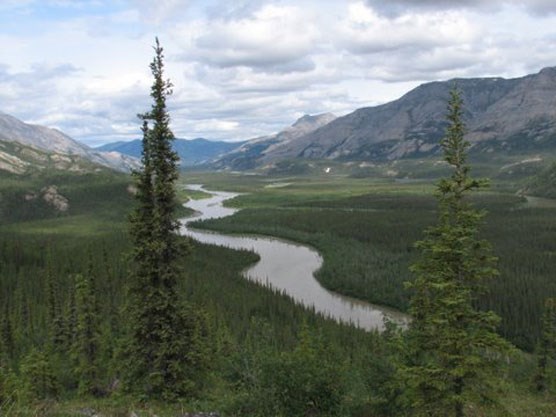
Liz McKenzie Plants If you traveled the length and breadth of Gates of the Arctic National Park and Preserve, you would spend much of your time in the boreal forest. This is the largest forest ecosystem on earth, encircling the northern world like a deep green wreath. But the boreal forest is not simply a vast unbroken timberland; it is a mosaic of diverse plant communities—swaths of spruce, aspen, and birch, braided together with shrub thickets, meadows, and boggy muskegs. To live here, plants must adapt to a spectacularly temperamental climate—warm summers with endless sunlight, followed by long, dark, bitterly cold winters. Rivers, streams, lakes and ponds are everywhere, and yet this is a very dry climate, even dryer than the desert. Soils are thin and nutrient poor, and inadequately drained because of the frozen earth below. And if all of these factors weren’t enough to tax the hardiest of plants, they must also adapt to frequent fires. The boreal forest is often called North America’s bird factory because of the incredible abundance and diversity of migratory birds that nest here every summer. Some species, like the Swainson’s thrush, fly at least 7,000 miles from tropical South America, drawn by the bounty of protein rich insects essential for their growing nestlings. Today, the boreal forest is also increasingly important because the plants, roots, and soils contain enormous amounts of carbon dioxide—this is called carbon sequestration. In fact, circumpolar forests store more carbon than any other terrestrial ecosystem—about 30 % of the total carbon on the earth’s continents. Scientists say that preserving the boreal forests may be vital for modulating climate change. In the higher elevations, the forest gives way to meadows and tundra, then to increasingly barren and forbidding landscapes of bedrock, scree, snow fields and glaciers. Plants of the slopes and high mountains are exposed to great extremes of cold, wind, and dryness. Many—like the lovely, purple-blossomed moss campion—hug the ground in tight little cushions, protecting them against wind and frost. On the north side of the Brooks Range, harsh weather, as well as permafrost near the surface, prevent the growth of forest. The land gives way to sprawling tundra dominated by low shrubs and grassy tussocks. This is a time of change in the far north—a “greening of the arctic”—as shown by the well documented increase in deciduous shrub cover—green alder, willow and birch. Studies suggest the cause could be global climate change. Because this may have serious impacts on plant communities and animals, many scientific studies are underway within Gates of the Arctic National Park and Preserve. |
Last updated: December 17, 2020
